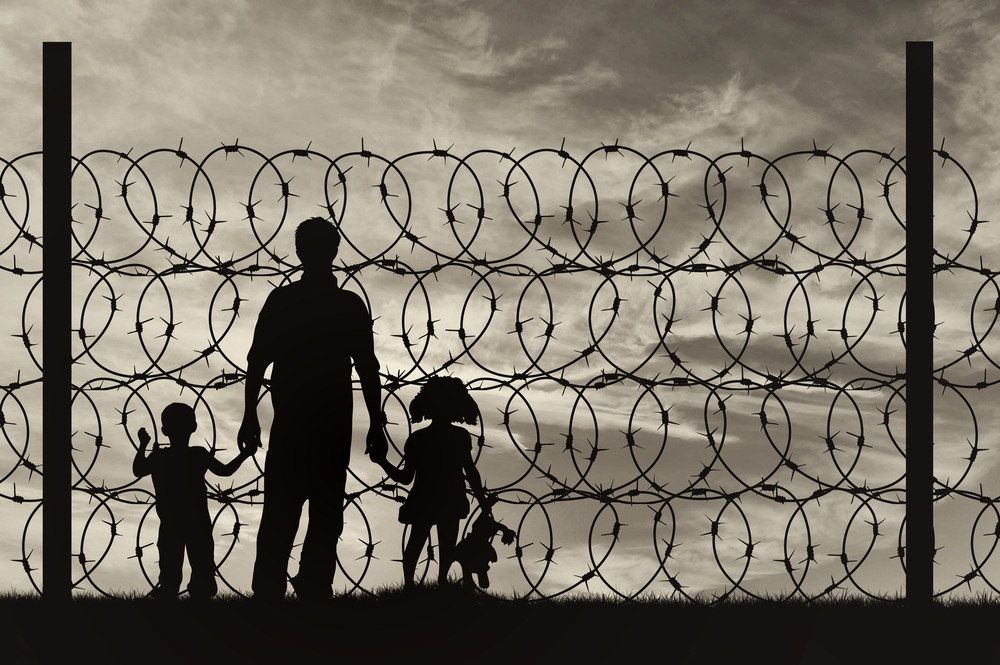
PrazisImages/Shutterstock
.
“Animals.” “Menace.” “Blood-stained killing fields.” These are all terms President Donald Trump used in a one-week period to describe undocumented immigrants, alleged members of MS-13 and the purported harm they are causing our country. The White House doubled down on these assertions by releasing an official statement titled, “What You Need to Know About the Violent Animals of MS-13.”

Rachel Marshall
Others in the administration have echoed these statements, including Thomas Homan, the acting U.S. Immigration and Customs Enforcement (ICE) director, who called the use of this language “kind.” On Wednesday of that same week, the Senate Judiciary Subcommittee on Border Security and Immigration held a hearing titled “TPVRA and Exploited Loopholes Affecting Unaccompanied Alien Children.” And on that same Wednesday, President Trump traveled to Long Island, NY for a forum “on immigration loopholes that enable MS-13 to infiltrate our communities.”
In the midst of headlines of babies and children being separated from their parents at the border, Trump invited parents of children who had been killed by undocumented immigrants to the White House that week, noting “[t]hey don’t talk about the death and destruction caused by people who shouldn’t be here.” Despite being an administration marked by chaos, it is hard to deny that this ongoing narrative is anything but a coordinated effort to promulgate a false narrative that immigrant youth should be feared. The facts show this could not be farther from the truth.
From the executive orders to target gangs, to ICE initiatives to arrest and deport unaccompanied minors and families, and the introduction of legislation from Congress that would increase the targeting of youth of color, we have seen the re-emergence of the idea of youth (particularly youth of color) as “superpredators.” The term “superpredator” gained traction in the 1990s after a report issued by John DeIulio called on the nation to fear young, wilding youth “who pack guns instead of lunches” and were purported to be the drivers of violent crime. This led to nearly every state in the nation passing laws making it easier to charge children as adults and to impose lengthy mandatory minimums and life without parole sentences. However, the predictions never materialized. In fact, youth crime is at a 30-year low, but youth and communities of color are still paying the price for these damaging and ineffective policies.
Truth about unaccompanied minors
If you are to believe the current rhetoric, the newest superpredator and cause of gang violence is the unaccompanied minor crossing our southern border. This is despite the fact that there is no evidence that unaccompanied minors are driving gang violence in the United States.
Between 2012-17, it is estimated that approximately 45,400 unaccompanied minors were apprehended. According to June 2017 written testimony from U.S. Border Patrol Acting Chief Carla Provost, since fiscal year 2012, U.S. Border Patrol apprehended 159 unaccompanied alien children with confirmed or suspected gang affiliations. Of these, 56 were suspected or confirmed to be affiliated with MS-13.
This is less than 0.1 percent of the unaccompanied minors that have entered the country. Rather, evidence on the ground indicates that most youth fleeing Central America are trying to flee gang violence and recruitment, not perpetuate it. Despite this fact, at least 821 immigrant youth under the age of 18 are detained in New York alone.
Once detained, many of these immigrant youth are subjected to severely inhumane treatment. A recent report by the Associated Press revealed that Latino youth, many of whom have been held after U.S. Immigration authorities accused them of gang membership, at the Shenandoah Valley Juvenile Center in Virginia have been abused by guards. According to a lawsuit filed on their behalf, teens as young as 14 were beaten while handcuffed and left nude in solitary confinement for long periods of time. A top manager from the juvenile center testified before Congress in April that, after being screened and assessed by staff, these youth did not appear to be gang involved and were in fact suffering from trauma that happened in their home countries.
As I’ve pointed out before, scapegoating immigrant youth is not the answer to ending gang violence. Not only does this vicious rhetoric and increased enforcement action actually feed MS-13’s goal, it also sows fear among those most susceptible to gang violence and those most likely able to help law enforcement combat gang violence. Take one unaccompanied minor from Brentwood, N.Y., whose story is far from unique.
Despite never being accused of committing a crime, police and immigration agents arrested the 16-year-old after he had been spotted in various places with people believed to be members of MS-13 by the police. Police also claimed that the teen scribbled the numbers “503” in his notebook. “503” is the international calling code for El Salvador, where the teen is from, but police also consider it a gang symbol. The teen was held for five months in detention centers across the country before he was ordered released due to the fact the federal government had failed to justify his detention.
Still, the police commissioner of Suffolk County, where Brentwood is located, stands by the arrest. According to National Public Radio, the commissioner’s police are also continuing to conduct surveillance of suspected gang members both in public schools and on the streets, which they then share with ICE. While the Brentwood teen and others like him were eventually released from detention, his story will likely make other youth in his situation scared to come forward and report to law enforcement if and when they are aware of real gang activity.
Outreach, support programs are needed
Recent unaccompanied minors are not the only youth of color to be targeted. A federal court case revealed that ICE arrested and detained a young man with DACA (Deferred Action for Childhood Arrivals) status. The young man, Daniel Ramirez Medina, was put into removal proceedings and ICE tried to strip him of his DACA status. ICE asserted that Ramirez was gang-affiliated and, among other deceptive actions, went as far as altering a statement Ramirez wrote in pencil to make it look like he confessed to being in a gang. A federal judge ultimately found that ICE had violated Ramirez’s rights and also violated federal law by stripping him of his DACA status. As evidenced by the story of the Brentwood teen, this is not the first time ICE has been accused of alleging Latino youth are gang-affiliated with little to no evidence and, even after the Ramirez case, it likely won’t be the last.
While organizations such as Make the Road NY are helping to organize locally and support immigrant communities facing such civil and human rights violations, it is not enough. Instead of demonizing immigrant youth and causing further isolation, the government should be supporting and investing in outreach programs, and community and family support services. Programs like S.T.R.O.N.G. Youth, Homies Unidos and Barrios Unidos help immigrant youth deal with trauma, family reunification and social stressors, among other issues, in order to ensure they feel connected to their new communities. Faith-based communities, such as Lutheran Social Services and Catholic Charities, who work to embrace and connect refugee children to families are also critical allies, as many children from Central America fleeing gang violence rely on their faith community to be a trusted ally.
As Evelyn Rodriguez, whose daughter was a victim of MS-13 in New York, pointed out: “These kids are coming in unaccompanied. They don’t know who to turn to. They’re afraid. They’re coming from a country that they were afraid with their law enforcement, people they couldn’t trust. Here we have to make sure that the resources and the programs are there for them.” I couldn’t agree more.
Rachel Marshall is the federal policy counsel for the Campaign for Youth Justice, a national initiative focused entirely on ending the practice of prosecuting, sentencing and incarcerating youth under the age of 18 in the adult criminal justice system.





























